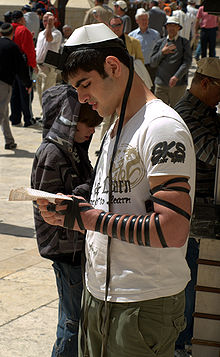Tefillin
Tefillin ( Hebrew תפילין təfillin , German 'prayer' (singular),תפילה təfilla (plural)), German phylacteries sometimes, phylacteries called, are a pair of black leather straps provided with small leather prayer capsules on parchment handwritten scrolls with texts from the Torah , the five books of Moses, included. Tefillin are worn by religious Jewish men - sometimes also by women in Reform Judaism - on weekdays during morning prayers (Hebrew Shacharit ). The arm part lies on the upper arm and the straps are wrapped around the arm, hand and fingers, the head part is worn over the forehead. The application of tefillin serves as a reminder to observe YHWH's commandments. Their shape, the way they are worn and the contents of the prayer capsules are laid down in the Talmud .
The tefillin


Tefillin consist of a headboard ( Hebrew תפילין של ראש tefillin schel rosch ) and one arm part (תפילין של יד tefillin schel jad ). They each have black leather straps (רצועות retzu'ot ) and a black leather case (בית bajit , pl.בתים batim ), in which small rolls of parchment with handwritten Torah sections second book of Genesis from 13.8 to 10 and 13.11 to 16 and the fifth book of Moses are 6.4 to 9 and 11.13 to 21. The commandment goes to these writings ( Hebrew מצוה Mitzwah ) tefillin to put on back. Both the leather and the parchment must come from ritually clean animals. The prayer capsules of head and arm tefillin differ in that the arm tefillin has all four sections on a parchment and in one chamber, while the head tefillin has four parchment rolls, each with a Torah section, in four separate ones Chambers are inserted. Since the Middle Ages , this has usually been done in the biblical order in both tefillins. The Hebrew script used is the same as that used for Torah scrolls.
The Shema Yisrael , the Jewish creed, as well as Deuteronomy 11: 13-21 ESV contain the request to bind "these words" as a sign on the hand and forehead, and also in two other passages in Exodus 13, 1–10 ELB and 13.11–16 ELB they should serve as signs on the arm and on the forehead.
“Listen, Israel: The Lord is our God, the Lord is only. And you shall love the Lord your God with all your heart and with all your soul and with all your might. And these words that I command you today should be in your heart. And you should instill it on your children, and you should talk about it when you sit in your house and when you walk on the road, when you lie down and when you get up. And you shall bind them as a sign on your hand, and they shall be as marks between your eyes, and you shall write them on the posts of your house and on your gates "
This invitation was taken literally, not figuratively, by the vast majority of Jewish Bible commentators. The Talmud largely stipulates how, when and where tefillin must be worn or taken off; in rabbinical literature , the explanations have been partially developed further, which has resulted in slight regional differences.
Wearing of tefillin has been attested since ancient times . Since the modern era , tefillin have only been worn by adult men (aged 13 and over), today mostly only by observant Jews of the orthodox and conservative directions. In ancient times and in the Middle Ages, and possibly also in modern times, women occasionally donned tefillin, a tradition that was resumed in the 20th century by women who belong to reformist egalitarian Judaism.
Kabbalists believe that the tefillin for the head are placed on the forehead to symbolize the spiritual connection of the soul with the Creator. In the tree of life this is kether (crown). The wrapping of the passive hand in each case stands for the side of the ego and egoism, which are to be tied up by the tefillin so that the good side can rise to God.
The application of the tefillin
- The arm tefillin are placed so that the prayer capsule rests on the biceps , and the straps are placed around the “weaker” arm seven times and then around the hand. Right-handers wear the hand tefillin on their left arm, left-handers on their right arm.
- The head tefillin are held over the forehead with a leather strap and tied with a knot at the back of the head; the two strap ends are worn hanging over the shoulder and forward.
The prayer capsule of the head tefillin bears the Hebrew letter Schin (ש) , for " Schaddai (Hebrew שדי)", German almighty , with the hand tefillin the word שדי (Schaddai) is formed from the straps.
literature
- Richard D. Hausmann: Tefillin. Regulations, customs and their interpretation. Morascha, Zurich 1988.
- Alexander Cowan: Tefillin. A letter treatise. New York 2005. ISBN 0-8266-0182-0
Web links
- The application of tefillin . Chabad Lubavitch , Baden
- Video . Chabad Lubavitch
- Virtual State Museum Mecklenburg: Prayer capsule from the 18th / early 19th century
Individual evidence
- ↑ a b c d Louis Isaac Rabinowitz: Tefillin. In: Encyclopaedia Judaica . 2nd Edition. Volume 19, Detroit / New York a. a. 2007, ISBN 978-0-02-865947-3 , pp. 577-580 (English).
- ↑ David Golinkin: May Women Wear Tefillin? (PDF; 134 kB) In: Conservative Judaism. 1997, accessed February 27, 2013 .
- ↑ Debra Nussbaum Cohen: Tefillin for Women, by Women. In: The Jewish Daily Forward . May 29, 2012, accessed February 27, 2013 .

